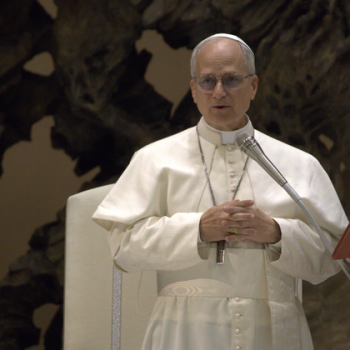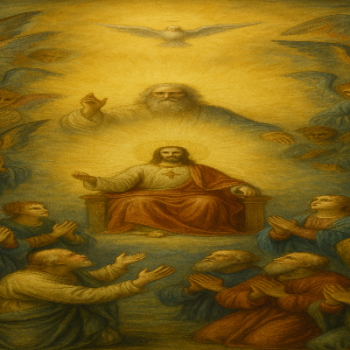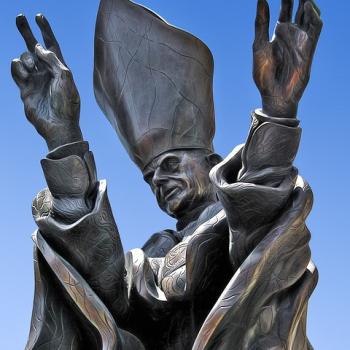
In seeking to understand the Holy Trinity, Thomas Aquinas identified five properties or notions that are proper to a Divine Person. I will endeavor to explain each of these notions in this paper. In so doing, I hope to add some illumination to the great mystery of the Holy Trinity.
Before commencing, a word about definitions. In philosophy, a property is a characteristic that is always present in a subject. For example, rationality is a property of a human being. A person may be tall or short, male or female, but a person is rational by virtue of his nature.
A notion (as used by Aquinas) is an idea whereby we know a Divine Person. The five notions that Aquinas attributes to Divine Persons are innascibility, procession, paternity, filiation, and spiration.
Innascibility
Thomas Aquinas uses the word innascibility as a property of God the Father. It is meant to connote that God the Father cannot be known by way of prior relations because there are no prior relations. This property of God the Father appears to distinguish Him from God the Son Who is eternally generated, and from the Holy Spirit, which proceeds from the Father and Son by spiration.
For the above reasons, Saint Augustine referred to God the Father as the “principle without principle.” It is a way of saying that God exists necessarily and is, therefore, not caused by another.
Therefore, God the Father cannot be known by the fact that He is from another; but by the fact that He is from no one. Thus, Aquinas calls this “innascibility.”
Procession
The procession, or more accurately, Divine procession, refers to the origin of a Divine person from another through the communication of the numerically one Divine essence.
Catholic theology identifies two internal processions in the Trinity: the begetting of the Son from the Father and the procession of the Holy Spirit from the Father and the Son. Because the procession is an intellectual one, the Divine Persons, not the Divine Nature, are the subjects of the internal divine procession. That is to say, though the Divine Persons differ numerically (there are three), they are one regarding their Divine nature.
The second Divine Person proceeds from the intellect of the first Divine Person by generation and therefore is related to him as Son to a Father. The third Divine Person proceeds from the will or mutual love of the Father and the Son from a single principle through spiration, and this is the Holy Spirit.
Filiation
Divine filiation is that doctrine that teaches that Jesus Christ is the only begotten Son of God the Father. As such, Jesus is of the same ousia or substance as the Father. That is to say that Jesus shares the same essence and nature as God.
However, there is a second level or dimension to the property of filiation. While Jesus is the Son of God the Father by nature of the Trinity, Catholics become the children of God through adoption.
Catholicism asserts that we become adopted children of God through our Baptism. Said differently, born of our natural parents in the flesh, we became their children; reborn of the spirit in the name of the Father, Son, and Holy Spirit (as a result of Baptism), we become God’s children (John. 3:5-6). As such, divine filiation is intimately related to justification. Without regressing into the subject too deeply, justification is the process whereby a sinner (we are all born into original sin) enters into a right relationship with God.
Paternity
Innascibility is the only property of the Divine Persons that is not relational. The reason being is that innascibility pertains to God the Father only.
Therefore, the first property or notion of the Divine Persons that is relational is paternity. Within the Holy Trinity, paternity refers to the generating of the Son by the Father.
In a sense, the use of the word paternity to denote the generation of the Son by the Father is only analogical to how paternity is used in human affairs. This is so because God the Father does not generate the Son in the way a man generates a child. The power of God to create is such that He speaks creation into existence (see Genesis 1:3 and Psalm 33:9).
Because God’s word is creative, the Son is generated intellectually. This is different from suggesting that this generation is ontological or temporal. Instead, the Father actively and eternally generates the Son. This is the meaning intended in the prologue of John’s Gospel. “In the beginning was the Word, and the Word was with God, and the Word was God.” Word is a translation of the Greek term logos. In turn, logos denotes the reason (as in the power of the intellect) of God.
Spiration
While the Old Testament makes oblique references to the Spirit of God and the Holy Spirit, it is only in the New Testament that we come to understand that the Holy Spirit is the third Person of the Holy Trinity.
Spiration refers to the breath or spirit of God, which is understood as the Holy Spirit. Specifically, the term is applied to the second procession in the Holy Trinity. The Holy Spirit proceeds from the Father and the Son. This procession is from the Persons of the Father and the Son and, as such, represents an act of the Divine will. As the Father is the Father only in relation to the Son, the paternal spiration is the voluntary diffusion of His goodness to the Son or paternal love; and, as the Son is the Son only concerning the Father, the filial spiration is His voluntary conformity to the Father or filial love.
Conclusion
God is the greatest of mysteries, and the Holy Trinity is the heart of this mystery. In seeking to understand the Trinity, Thomas Aquinas developed the five notions or properties of the Trinity.
In this paper, I have endeavored to explain innascibility, procession, paternity, filiation, and spiration. With the exception of innascibility, these notions provide insight into the relations among the three Divine Persons of the Holy Trinity.















